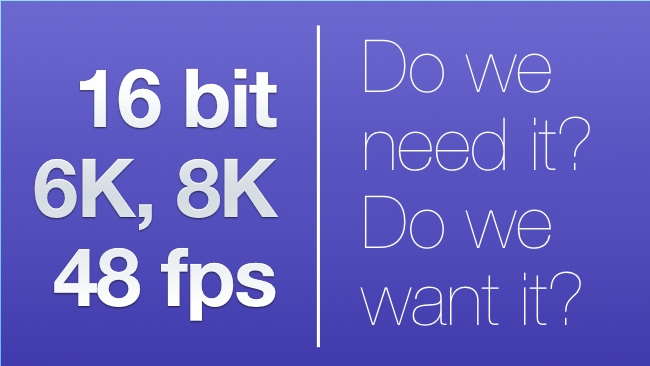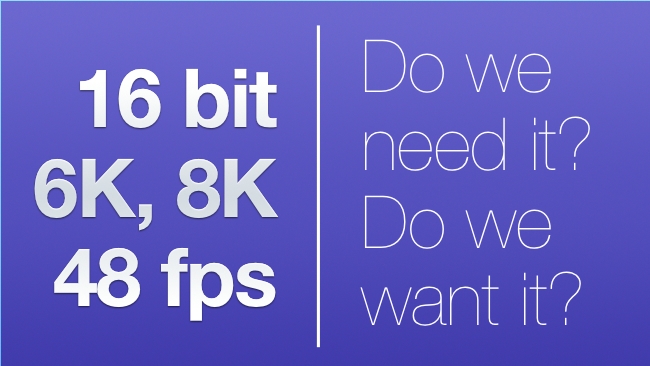
 Do we need anything better?
Do we need anything better?
Another chance to read about this fascinating debate. This was first published in April 2014. Just because we can do 16 bit, High Dynamic Range, 6K and 8K: does that mean we need it? Here's where to start in the debate
At NAB [last] year, Curtis Clark, ASC, moderated a fascinating discussion of modern HDR (High Dynamic Range) techniques, monitoring HDR images with 4000-nit displays, and the artistic and practical application of extended dynamic range. Almost simultaneously, Quantel were promoting their newly upgraded Genetic Engineering product, now at version 2 with comprehensive shared storage facilities for difficult-to-handle media in the 4K, 16 bit sort of range, and at high frame rate. Of course, NAB is a trade show, and we’d expect nothing less than forceful promotion of the newer, bigger numbers from the world of filmmaking, but if you think about it, there’s much here to give us pause beyond the simple assumption that more is better.
Of course it is!
But it is. Of course it is, and nobody’s seriously arguing. Greater capability leads, one way or another, to output that is objectively better. But filmmaking is an artform and therefore not an entirely objective subject, and there’s an issue of purpose here that did come up in the audience questions at Clark’s event. I’ve written before about the fact that 35mm film, as distributed to paying audiences, never achieved 4K (it may barely do so on the original camera negative, depending on stock). Douglas Trumbull’s 60fps 70mm Showscan system, which probably did have that ability as well as the high frame rates of modern digital cameras, failed to take off. Now, one could blame the alarmingly higher cost for that particular sputtering-out, but there were also concerns about the appearance of the recent Hobbit movie, shot as it was at a higher than average frame rate.
I must emphasise that I don’t intend to build a case that progress is always bad thing based on that one example, especially as Hobbit was a 3D movie and 3D is probably helped by high frame rate, but the point remains. In many peoples’ minds, the purpose of cameras shooting at rates above the traditional 24fps is to shoot slow motion. The purpose of 6K, if not 4K, cameras might be so as to have spare resolution to reframe, stabilize, and increase gain without objectionable noise. The purpose of high dynamic range might be to ease lighting concerns with very high contrast subjects – someone indoors, in front of a window, perhaps – as well as to make highlights prettier.
Advantages
All of these are advantages of progress in camera technology that don’t actually require us to distribute anything more than 2K DCPs in DCI P3 colourspace, or Rec. 709 broadcast masters. Of course there are commercial incentives for people to want to sell us new equipment, particularly people who would like to continually replace the world’s installed stock of theatrical projection systems every few years. Ultimately, though, I think there’s a destination in all this. Even if we accept that 16-stop cameras, or 4, 6 or 8K pictures are useful – and I think even 6 is a severe stretch – does this mean that we’ll be back here in 2025 having the same talk about 16 or 32K at 1000fps? There’s a sanity-imposed limit on the ability of bigger numbers to be sensibly used as a promotional tool, even if that limit isn’t one we’ve met quite yet.
Film is an artform
It’s becoming clear that at some point, film is an artform in the same way as – say - creative writing. The invention of the printing press revolutionised the creation and distribution of written words, but the technology is now so trivial (and so overtaken by the internet) that we wouldn’t look to the creators of a particular printing press to influence a novel’s potential for success. Those things are of interest to specialists, but specialists don’t define the market. What defines the market is the lay audience, and if the lay audience has decided that 2K, 24fps, 13-stop cameras make results that are what a movie looks like, actually distributing more is not only unnecessary, it may, as the reaction to Hobbit shows, be actively problematic. People like the stroboscopy of 24fps imaging, sometimes. It has an affect on us, as the use of short shutter angles in the chaotic opening scenes of Saving Private Ryan demonstrate. People like harsh colour and limited dynamic range, as Traffic shows us. These are extreme examples, but they make the point clearly.
I’m happy as anything to see more capability in cameras, but we should be careful to consider whether the purpose of that is to show more to the audience, or to make a better job of the output formats we currently serve. The experience of filmmakers like the late, great Tony Scott, with his use of deliberately-mistreated (cross-processed, pushed, etc) film shows that we may not even have to make a choice, simply because a 6K, 16-stop, wide-gamut imaging pipeline remains capable of transmitting a 2K, 10-stop monochrome image. Flexibility is nice, capability is nice. But let’s not crash headlong into a future that requires every movie to look like a window onto an alternative reality. That isn’t what some movies are supposed to look like.
Tags: Technology


Comments